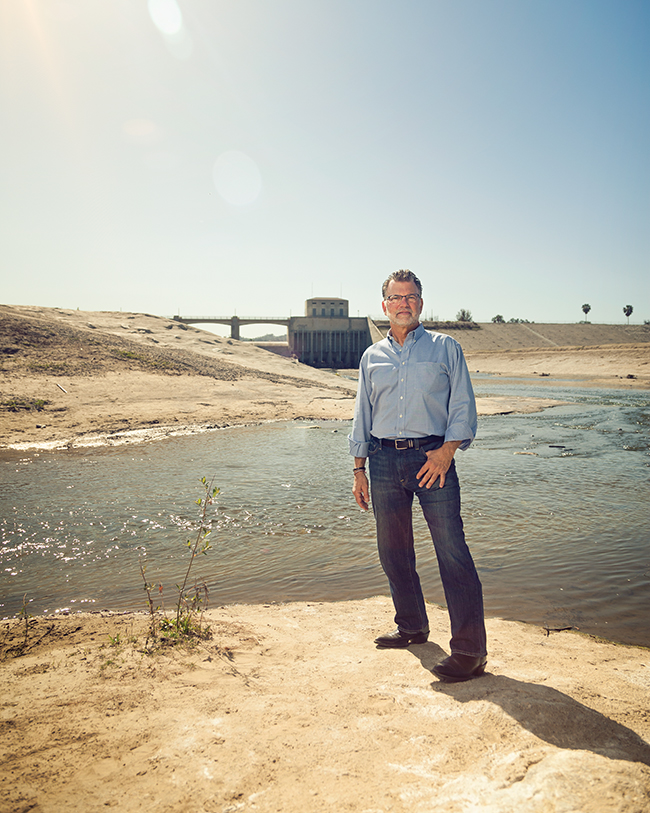
Dry Times
Former California assemblyman and Water Resources Control Board member Richard Katz was the state’s lead negotiator on the landmark 2003 Colorado River Quantification Settlement. Here we get the Studio City-based consultant’s perspective on coping with the lowest rainfall since 1977.
-
CategoryPeople
-
Edited byLinda Grasso
Put this drought in perspective for us.
This is the driest year in 164 years of recorded history. And even if it rained every other day until May, we may get back to average rainfall totals, but we’d still be in the third year of this drought.
Will lack of rainfall always be an issue?
There is never enough water to waste in Cali-fornia. Stop watering outdoors entirely. Keep showers short. Run washing machines and dishwashers only with a full load. Remember, we live in a natural desert that was “greened” by importing water from the Owens Valley (near Mammoth) and Northern California. When combined with global warming, serious shortfalls-or droughts-are more likely to become the norm than the exception.
Stop watering entirely? Is that realistic for most homeowners?
It means switching to drought-tolerant plants, conserving in the house, using rain barrels, replacing grass with synthetic lawn and covering pools.
What is Mayor Garcetti doing about the drought?
The mayor sets the tone for the city. Garcetti’s new DWP general manager, Marcie Edwards, has a proven track record at running a well-managed utility. (She ran Anaheim Public Utilities for more than a decade.) Marcie brings a ratepayer, conservation and efficiency mindset to the job. Hiring her was a very smart move.
What about Governor Brown?
Governor Brown has been working toward a statewide water solution for several years and supports a multi-billion dollar bond measure, designed to increase conservation and stor- age as well as develop local water supplies through the use of reclaimed water, stormwater capture and water recycling.
The state has announced the award of $153 million to help fund 138 separate water projects around the state. And Governor Brown has signed a bipartisan, $687.4 million drought relief plan, which includes accelerated funding for local infrastructure grants to increase local reliability and direct expenditures to agencies to improve water use efficiency, save energy and reduce greenhouse gas emissions from water transportation and management systems.
Are we taking the water shortage seriously enough?
As long as you can turn on the faucet and water comes out, no one thinks too much about water supply. But this is serious stuff, and we can’t continue to ignore it. It’s up to elected officials, appointed officials and neighborhood leaders to make sure that everyone can make an informed decision and do their part. That’s the only way we won’t be passing on to our children another serious crisis.
Anything else you’d like to add?
It’s important to know that the vast majority of water in California is used by agriculture. And while there have been many improvements in how farms use water, there is a lot more that can be conserved. That doesn’t mean we should just sit around and wait for the ag water; we have to take responsibility too.
Rules & Rates
In January, Governor Brown declared a California drought emergency, and the LADWP activated the city’s mandatory Emergency Water Conservation Plan, including “odd/even” watering days.
• If street address number is an ODD number, water Mondays, Wednesdays and Fridays.
• If street address number is an EVEN number, water Tuesdays, Thursdays and Sundays.
• Limit sprinkler runs (per station) to 8 minutes before 9 a.m. and after 4 p.m. only.
Beginning June 1, shortage year rates go into effect for all LADWP customers. This reduces the amount of water we are able to purchase at the lowest price and increases the rates we will pay when usage exceeds a certain amount.
Ways to Conserve
Get a pool cover
Gallons saved per year: 14,239. Cost savings per year: $114.
“Our pool cover helps maintain the heat and reduces evaporation. It’s a win-win,” says Richard.
Reduce turf
At 250 square feet, gallons saved per year: 10,997.
Cost savings per year: $88.
“LADWP increased this rebate from $1.50 to $2 per square foot of grass replaced with water-efficient landscaping, up to a limit of $4,000. I recently installed artificial turf at my house, and it looks amazing—and no one has to mow it!”
Fix leaks (toilet, faucet, irrigation)
Gallons saved per year: 10,000.
Cost savings per year: $80.











